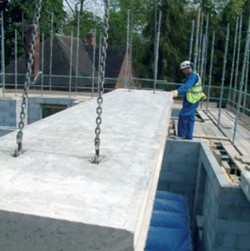In the December issue of ABC+D Magazine, Mike Nelson of Bison Manufacturing, discusses the ways in which Modern Methods of Construction, such as the use of offsite manufacture, can allow the quick installation of high-quality flooring units and the wider benefits that this can provide to a building’s occupants following completion…
The UK’s faltering performance in the construction sector is, sadly, well publicised. According to the Office for National Statistics, the July-September 2016 quarter saw construction volumes fall by 1.1%, marking the period as the industry’s worst in four years
As is often the case, this is not due to one factor in particular but, rather, a mixture of different causes. For instance, recent political changes have seen increased uncertainty around labour availability, which in-turn has a knock-on effect on skilled trades such as bricklayers, roofers and flooring fitters.
As the Government is already falling short of its commitment to build one million new homes by 2020, it is time to look at the use of alternative construction methods which can help to alleviate the burden.
As a nation, the UK can be quite set in its ways when it comes to construction, especially when we think of our homes. Brick walls, slate roofs and of course, wooden floorboards, are all part and parcel of a traditional home but, given labour shortages and the number of new houses we need, isn’t it time we moved on?
In recognition of the need to change the face of the industry to meet demand, there are already discussions in Government about making use of offsite construction to build more than 100,000 new homes, and precast concrete units can help to realise this objective.
As with other panels or units manufactured offsite, precast concrete can be produced to a consistently high quality, thanks to it being manufactured under factory-controlled conditions with thorough quality control procedures. A further benefit is the ability for precast units to be installed immediately upon their arrival on site.
Everyone knows that weather conditions in the UK are very changeable, with rain and low temperatures being commonplace. When using poured concrete for ground floors, these conditions can have a negative impact on the quality of the floor, while long curing times can see other elements of a project being delayed until the floor can be built upon.
Precast floor units, on the other hand, are ready to be built on straight from the factory and can be used on both the ground and upper floors to create an immediate un-propped worked platform for the other trades on site. Of course, while faster construction benefits contractors and developers, it is also vital that a home appeals to its end users.
Precast concrete floor units can offer excellent fire resistance, providing peace-of-mind for a building’s occupants, but it is the material’s insulating properties that really stand out.
While concrete already has a low level of thermal conductivity, helping to minimise heat loss, some precast concrete manufacturers can also provide insulated Hollowcore flooring units. These offer all of the durability associated with concrete, with added insulating properties, reducing the amount of additional insulation needed in a property.
Units are also available with underfloor heating pipework already cast in to the concrete, allowing developers to offer their customers this option in high-end residential settings without the need for additional screeding to be carried out, or for costly overlay heating systems to be added.
A further benefit is concrete’s intrinsically high acoustic insulation, effectively providing greatly superior sound deadening properties compared to traditional floorboards. This is particularly important in the home, whether in larger apartment buildings or in standalone houses, where reduced noise travel helps to create a more relaxing atmosphere, while also doing away with the problem of creaking floorboards.
With demand for homes only expected to rise and labour levels reduced while new apprenticeship and training schemes are put in place, it is clear that a new approach must be taken to the various elements of housing construction, with flooring forming the anchor on which a project is built.
By looking to offsite manufacture and modular construction, architects, contractors and developers alike can experience the benefits of faster, more consistent construction, while buildings’ end users will be provided with safe, warm and comfortable homes for decades to come.
Original link - Buildingtalk









